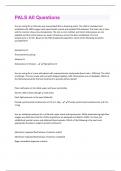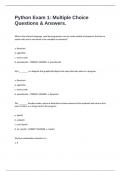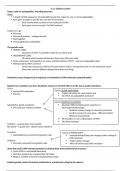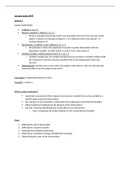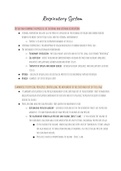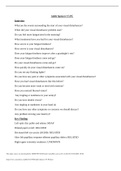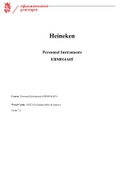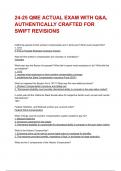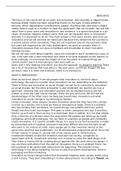Contract Law
Problems in the agreement process: Misrepresentation; Mistake
- Misrepresentation gives rise to a cause in negligence
- Negligent misrepresentation can be proven using the Misrepresentation Act 1967
- the Act creates the statutory right of misrepresentation for contracting parties only
Misrepresentation Act 1967
- No change to definition of misrepresentation
- Creates cause of action for misrep for contracting parties only
- Section 2(1) makes damages available for negligent misrep (historically, the only remedy for
non-fraudulent misrep was rescission)
- gives damages
- Defence available to representor: if he had reasonable grounds to believe statement was
true.
- Gives the maker of the statement a defence, but they may still be convicted for innocent mis-
rep
- Howard Marine v Ogden
- Claimant wanted to hire a barge to transport clay up the Thames
- The defendant was in the business of hiring out barges
- D claimed that one barge was capable of carrying 16,000 tonnes of clay
- He got that figure from what was normally a reliable source— the Lloyd’s shipping register
- However, the register was wrong, carrying capacity was only 1000 tonnes
- The Defendant tried to argue that he had reasonable grounds to think the register was true
- But he hadn’t discharged the burden of proof, he should have gone to the register of the ship
to check if it was accurate
- Not able to rely on this defence
- Liability under s2(1) established via 'fiction of fraud'
- Criticized for the fraud part, if the person has been honest we still treat them as if they acted
fraudulently especially considering the amount of damages they have to pay
- not the same moral grounds associated with fraud and negligence
- Has the effect that if a C brings his suit under s 2(1), he gets the fraud measure of damages
without actually proving fraud
- S 2(2) makes damages available for innocent misery
- damages for non negligent misery
- Only deals with the situation between two contracting parties
- Not if there is a third party
Excerpts from Misrepresentation Act 1967
- Section 2(1) “Where a person has entered into a contract after a misrepresentation has been
made to him by another party thereto and as a result thereof he has suffered loss, then, if the
person making the misrepresentation would be liable to damages in respect thereof had the
misrepresentation been made fraudulently, that person shall be so liable notwithstanding that
, the misrepresentation was not made fraudulently, unless he proves that he had reasonable
ground to believe and did believe up to the time the contract was made the facts represented
were true.”
- Section 2(1) provides a statutory action for misrepresentation which has certain advantages
over the action for fraud.
- (i) For section 2(1) of the Act to operate, the representee (the person to whom the statement
is made) must have entered into a contract with the representor (the maker of the statement)
following the representation. Therefore if a false statement made by A to B induces B into a
contract with C, A will not be liable to B for his false statement under the Misrep Act. Liability
may arise under another branch of the law (specifically the tort of negligent misstatement un-
der the authority of Hedley Byrne v Heller [1964] AC 465).
- (ii) Under the Act, the representor (the person making the statement) bears the burden of
proof in showing that he had reasonable grounds to believe, and did believe, the statement
was true. If he discharges this burden he will escape liability under s2.1 of the Act (but may
have made an innocent misrepresentation for which he may be liable to pay damages under
s 2.2). Discharging the burden of proof of s2(1) can be difficult:
- Howard Marine and Dredging v Ogden [1978] QB 574.
- (iii) Imposition of liability under s 2(1) is by reference to the ‘fiction of fraud’. This gives rise to
the possibility of the fraud measure of damages (under tort of deceit), which is quite generous
(representor liable for all losses arising directly from the false representation, whether fore-
seeable by him or not, which is a more generous test than that operating under the general
law of contract, and the tort of negligence.)
Remedies for Misrepresentation
- Effect of misrep is to make contract voidable
- the contract will continue to exist until one of the parties takes steps to void it
- Does not make it void from the start, simply leaves it to the innocent party to elect what they
want to do
- Rescission: equitable and discretionary remedy that returns parties to pre-contract position
- Not a common law remedy
- Will undue the effects of the contract, return party to the pre-contract position
- Rescission is available in principle for all types of misrep where a contract has resulted
- But note effect of 2(2) Misrep Act 1967 - this section allows the party to recover damages
- Self-help remedy
- the parties do not have to rely on a court order to rescind the contract
- You can simply inform the other party that the contract is rescinded. If the other party does
not agree then you will need a court order to enforce it
- For all types of misrep the Claimant is generally entitled to recision
- 2(2) “Where a person has entered into a contract after a misrepresentation has been made to
him otherwise than fraudulently, and he would be entitled, by reason of the misrepresenta-
tion, to rescind the contract, then, if it is claimed, in any proceedings arising out of the con-
tract, that the contract ought to be or has been rescinded, the court or arbitrator may declare
the contract subsisting and award damages in lieu of rescission, if of opinion that it would be
equitable to do so, having regard to the nature of the misrepresentation and the loss that
Problems in the agreement process: Misrepresentation; Mistake
- Misrepresentation gives rise to a cause in negligence
- Negligent misrepresentation can be proven using the Misrepresentation Act 1967
- the Act creates the statutory right of misrepresentation for contracting parties only
Misrepresentation Act 1967
- No change to definition of misrepresentation
- Creates cause of action for misrep for contracting parties only
- Section 2(1) makes damages available for negligent misrep (historically, the only remedy for
non-fraudulent misrep was rescission)
- gives damages
- Defence available to representor: if he had reasonable grounds to believe statement was
true.
- Gives the maker of the statement a defence, but they may still be convicted for innocent mis-
rep
- Howard Marine v Ogden
- Claimant wanted to hire a barge to transport clay up the Thames
- The defendant was in the business of hiring out barges
- D claimed that one barge was capable of carrying 16,000 tonnes of clay
- He got that figure from what was normally a reliable source— the Lloyd’s shipping register
- However, the register was wrong, carrying capacity was only 1000 tonnes
- The Defendant tried to argue that he had reasonable grounds to think the register was true
- But he hadn’t discharged the burden of proof, he should have gone to the register of the ship
to check if it was accurate
- Not able to rely on this defence
- Liability under s2(1) established via 'fiction of fraud'
- Criticized for the fraud part, if the person has been honest we still treat them as if they acted
fraudulently especially considering the amount of damages they have to pay
- not the same moral grounds associated with fraud and negligence
- Has the effect that if a C brings his suit under s 2(1), he gets the fraud measure of damages
without actually proving fraud
- S 2(2) makes damages available for innocent misery
- damages for non negligent misery
- Only deals with the situation between two contracting parties
- Not if there is a third party
Excerpts from Misrepresentation Act 1967
- Section 2(1) “Where a person has entered into a contract after a misrepresentation has been
made to him by another party thereto and as a result thereof he has suffered loss, then, if the
person making the misrepresentation would be liable to damages in respect thereof had the
misrepresentation been made fraudulently, that person shall be so liable notwithstanding that
, the misrepresentation was not made fraudulently, unless he proves that he had reasonable
ground to believe and did believe up to the time the contract was made the facts represented
were true.”
- Section 2(1) provides a statutory action for misrepresentation which has certain advantages
over the action for fraud.
- (i) For section 2(1) of the Act to operate, the representee (the person to whom the statement
is made) must have entered into a contract with the representor (the maker of the statement)
following the representation. Therefore if a false statement made by A to B induces B into a
contract with C, A will not be liable to B for his false statement under the Misrep Act. Liability
may arise under another branch of the law (specifically the tort of negligent misstatement un-
der the authority of Hedley Byrne v Heller [1964] AC 465).
- (ii) Under the Act, the representor (the person making the statement) bears the burden of
proof in showing that he had reasonable grounds to believe, and did believe, the statement
was true. If he discharges this burden he will escape liability under s2.1 of the Act (but may
have made an innocent misrepresentation for which he may be liable to pay damages under
s 2.2). Discharging the burden of proof of s2(1) can be difficult:
- Howard Marine and Dredging v Ogden [1978] QB 574.
- (iii) Imposition of liability under s 2(1) is by reference to the ‘fiction of fraud’. This gives rise to
the possibility of the fraud measure of damages (under tort of deceit), which is quite generous
(representor liable for all losses arising directly from the false representation, whether fore-
seeable by him or not, which is a more generous test than that operating under the general
law of contract, and the tort of negligence.)
Remedies for Misrepresentation
- Effect of misrep is to make contract voidable
- the contract will continue to exist until one of the parties takes steps to void it
- Does not make it void from the start, simply leaves it to the innocent party to elect what they
want to do
- Rescission: equitable and discretionary remedy that returns parties to pre-contract position
- Not a common law remedy
- Will undue the effects of the contract, return party to the pre-contract position
- Rescission is available in principle for all types of misrep where a contract has resulted
- But note effect of 2(2) Misrep Act 1967 - this section allows the party to recover damages
- Self-help remedy
- the parties do not have to rely on a court order to rescind the contract
- You can simply inform the other party that the contract is rescinded. If the other party does
not agree then you will need a court order to enforce it
- For all types of misrep the Claimant is generally entitled to recision
- 2(2) “Where a person has entered into a contract after a misrepresentation has been made to
him otherwise than fraudulently, and he would be entitled, by reason of the misrepresenta-
tion, to rescind the contract, then, if it is claimed, in any proceedings arising out of the con-
tract, that the contract ought to be or has been rescinded, the court or arbitrator may declare
the contract subsisting and award damages in lieu of rescission, if of opinion that it would be
equitable to do so, having regard to the nature of the misrepresentation and the loss that

